Effects of Total Quality Management Practices at UPS: A Review
VerifiedAdded on 2022/01/19
|26
|8889
|475
Report
AI Summary
This report examines the effects of Total Quality Management (TQM) practices on the performance of United Parcel Service (UPS). The study reviews existing literature and explores the relationships between TQM components, such as customer focus, training and education, top management commitment, teamwork, and continuous improvement, and various performance metrics. The report delves into the background of the courier service industry and the specific context of UPS, employing a research approach that likely involves analyzing the impact of these TQM practices on key performance indicators, including customer satisfaction, revenue growth, and operational efficiency. It highlights the importance of customer orientation, training, management support, and teamwork in achieving quality service and organizational success. The report also presents a research methodology, including data collection, analysis techniques, and discusses the validity and reliability of the findings. The objective is to assess how TQM practices influence the overall performance of courier service companies like UPS.
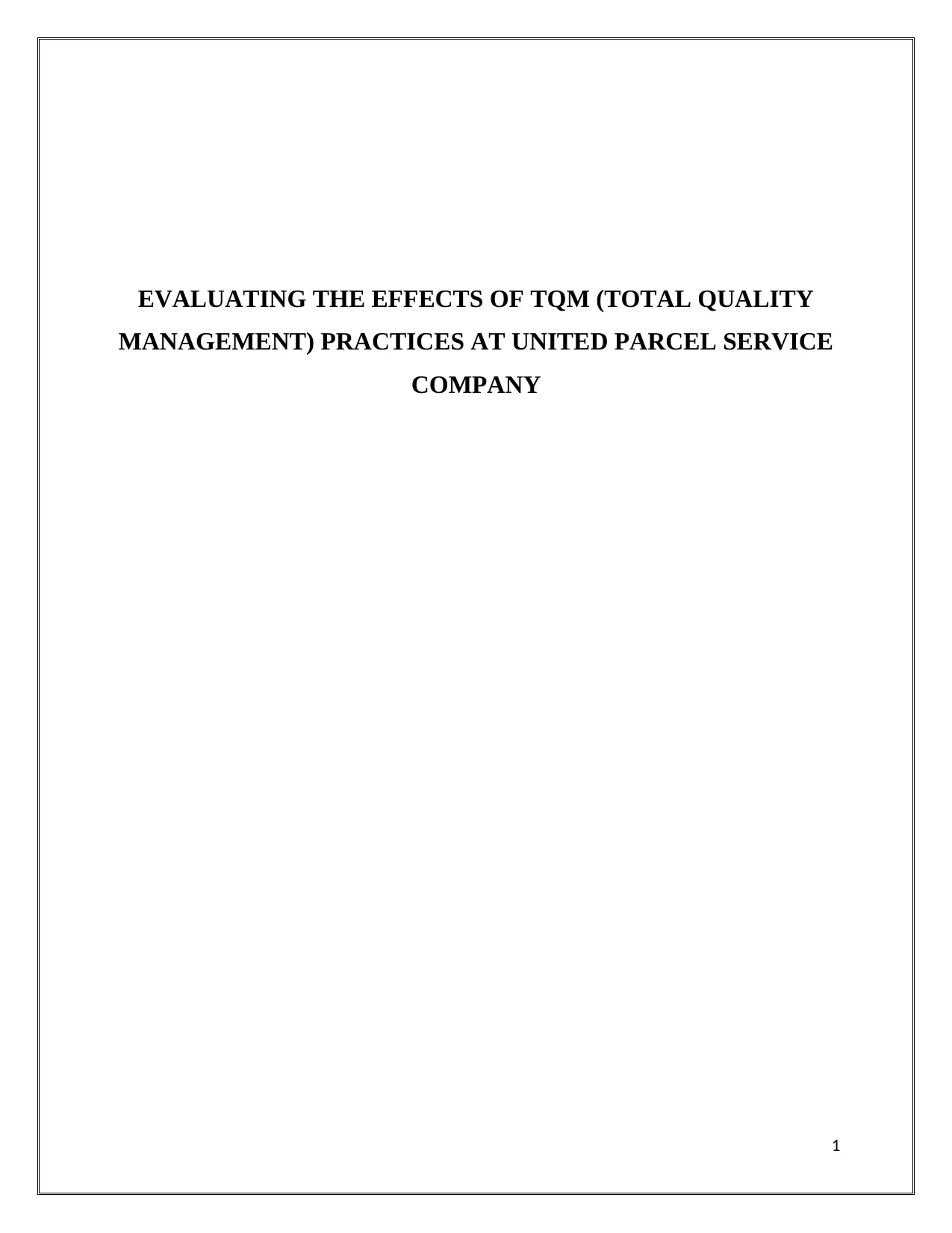
EVALUATING THE EFFECTS OF TQM (TOTAL QUALITY
MANAGEMENT) PRACTICES AT UNITED PARCEL SERVICE
COMPANY
1
MANAGEMENT) PRACTICES AT UNITED PARCEL SERVICE
COMPANY
1
Paraphrase This Document
Need a fresh take? Get an instant paraphrase of this document with our AI Paraphraser
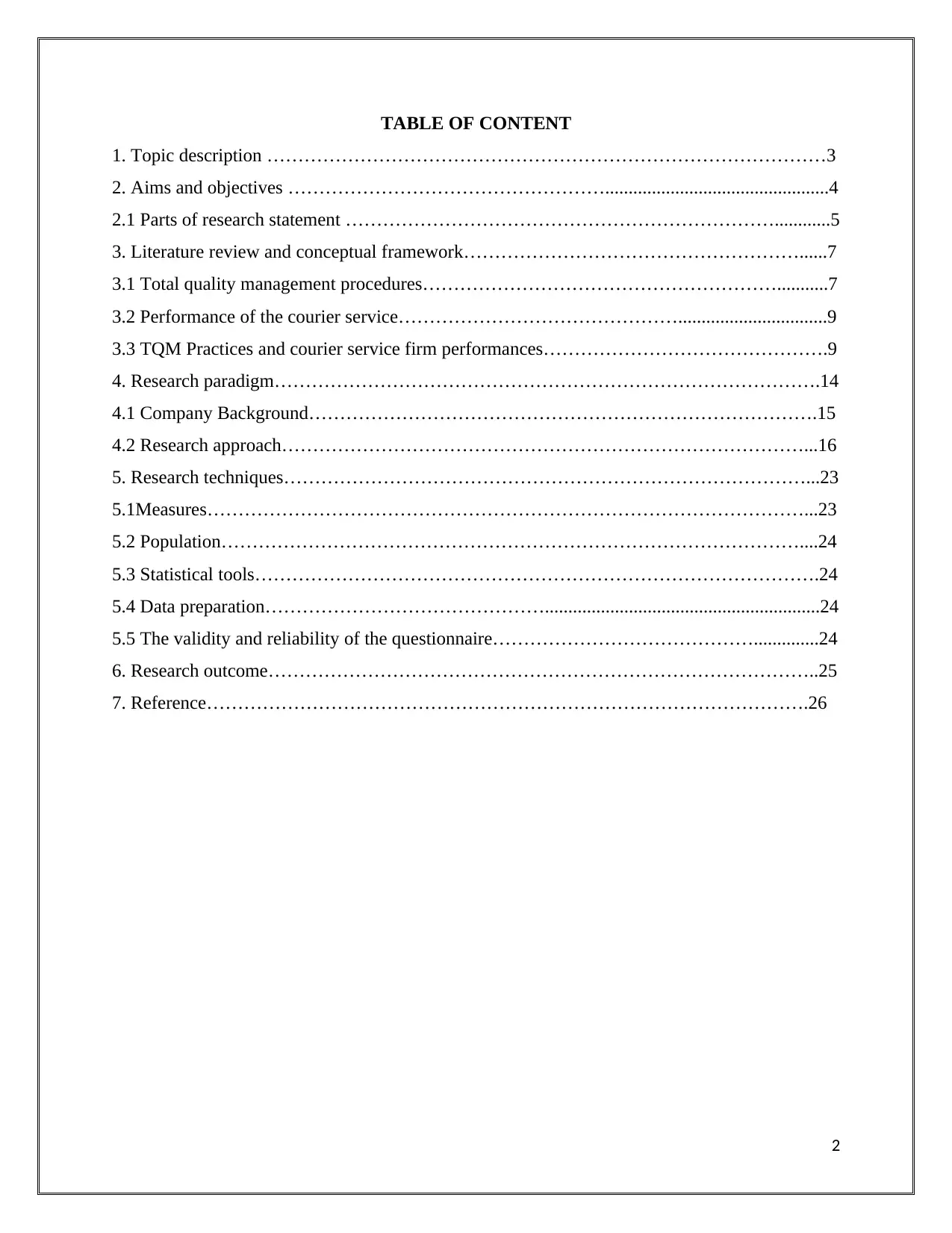
TABLE OF CONTENT
1. Topic description ………………………………………………………………………………3
2. Aims and objectives ……………………………………………................................................4
2.1 Parts of research statement ……………………………………………………………............5
3. Literature review and conceptual framework………………………………………………......7
3.1 Total quality management procedures…………………………………………………...........7
3.2 Performance of the courier service………………………………………................................9
3.3 TQM Practices and courier service firm performances……………………………………….9
4. Research paradigm…………………………………………………………………………….14
4.1 Company Background……………………………………………………………………….15
4.2 Research approach…………………………………………………………………………...16
5. Research techniques…………………………………………………………………………...23
5.1Measures……………………………………………………………………………………...23
5.2 Population…………………………………………………………………………………....24
5.3 Statistical tools……………………………………………………………………………….24
5.4 Data preparation………………………………………...........................................................24
5.5 The validity and reliability of the questionnaire……………………………………..............24
6. Research outcome……………………………………………………………………………..25
7. Reference…………………………………………………………………………………….26
2
1. Topic description ………………………………………………………………………………3
2. Aims and objectives ……………………………………………................................................4
2.1 Parts of research statement ……………………………………………………………............5
3. Literature review and conceptual framework………………………………………………......7
3.1 Total quality management procedures…………………………………………………...........7
3.2 Performance of the courier service………………………………………................................9
3.3 TQM Practices and courier service firm performances……………………………………….9
4. Research paradigm…………………………………………………………………………….14
4.1 Company Background……………………………………………………………………….15
4.2 Research approach…………………………………………………………………………...16
5. Research techniques…………………………………………………………………………...23
5.1Measures……………………………………………………………………………………...23
5.2 Population…………………………………………………………………………………....24
5.3 Statistical tools……………………………………………………………………………….24
5.4 Data preparation………………………………………...........................................................24
5.5 The validity and reliability of the questionnaire……………………………………..............24
6. Research outcome……………………………………………………………………………..25
7. Reference…………………………………………………………………………………….26
2
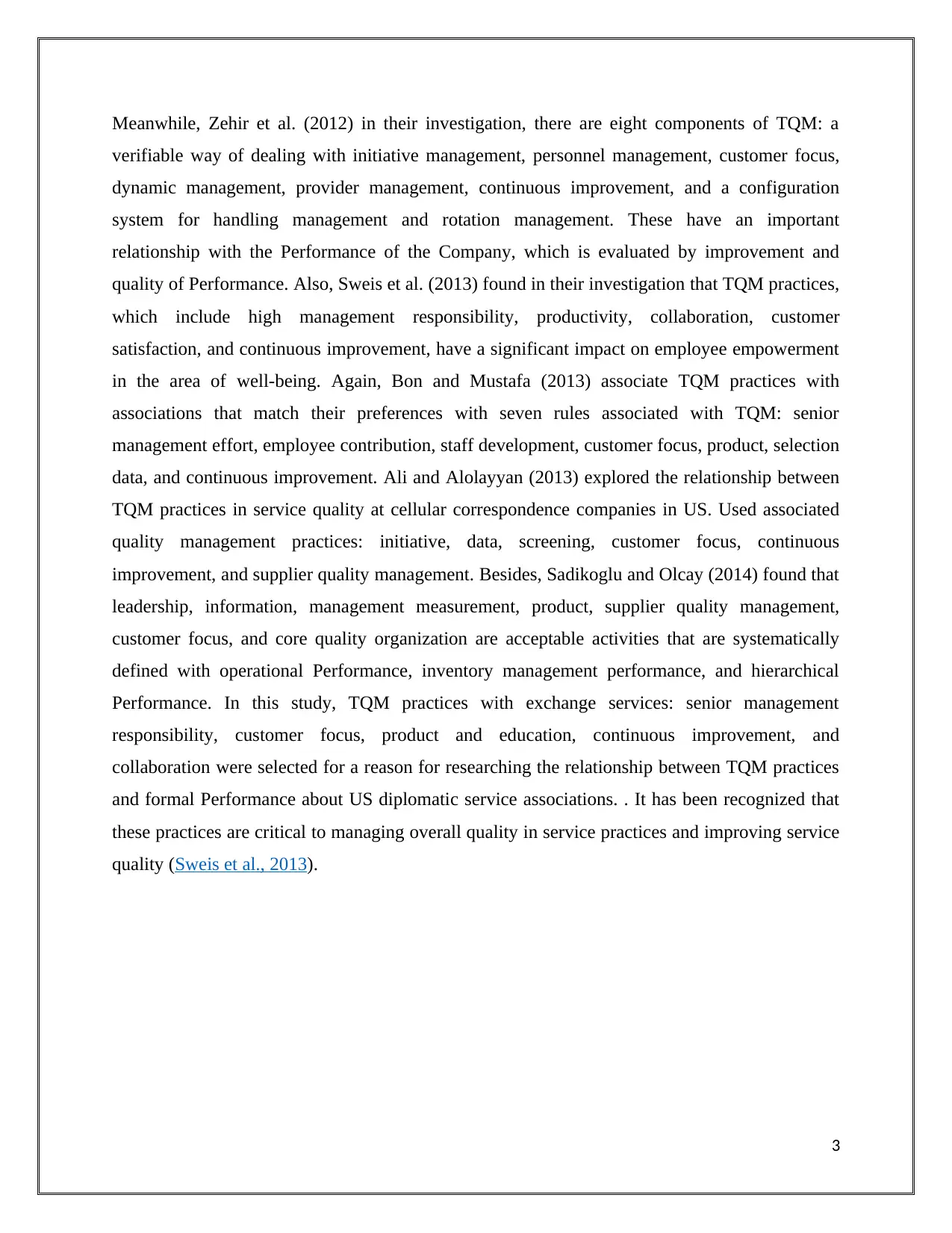
Meanwhile, Zehir et al. (2012) in their investigation, there are eight components of TQM: a
verifiable way of dealing with initiative management, personnel management, customer focus,
dynamic management, provider management, continuous improvement, and a configuration
system for handling management and rotation management. These have an important
relationship with the Performance of the Company, which is evaluated by improvement and
quality of Performance. Also, Sweis et al. (2013) found in their investigation that TQM practices,
which include high management responsibility, productivity, collaboration, customer
satisfaction, and continuous improvement, have a significant impact on employee empowerment
in the area of well-being. Again, Bon and Mustafa (2013) associate TQM practices with
associations that match their preferences with seven rules associated with TQM: senior
management effort, employee contribution, staff development, customer focus, product, selection
data, and continuous improvement. Ali and Alolayyan (2013) explored the relationship between
TQM practices in service quality at cellular correspondence companies in US. Used associated
quality management practices: initiative, data, screening, customer focus, continuous
improvement, and supplier quality management. Besides, Sadikoglu and Olcay (2014) found that
leadership, information, management measurement, product, supplier quality management,
customer focus, and core quality organization are acceptable activities that are systematically
defined with operational Performance, inventory management performance, and hierarchical
Performance. In this study, TQM practices with exchange services: senior management
responsibility, customer focus, product and education, continuous improvement, and
collaboration were selected for a reason for researching the relationship between TQM practices
and formal Performance about US diplomatic service associations. . It has been recognized that
these practices are critical to managing overall quality in service practices and improving service
quality (Sweis et al., 2013).
3
verifiable way of dealing with initiative management, personnel management, customer focus,
dynamic management, provider management, continuous improvement, and a configuration
system for handling management and rotation management. These have an important
relationship with the Performance of the Company, which is evaluated by improvement and
quality of Performance. Also, Sweis et al. (2013) found in their investigation that TQM practices,
which include high management responsibility, productivity, collaboration, customer
satisfaction, and continuous improvement, have a significant impact on employee empowerment
in the area of well-being. Again, Bon and Mustafa (2013) associate TQM practices with
associations that match their preferences with seven rules associated with TQM: senior
management effort, employee contribution, staff development, customer focus, product, selection
data, and continuous improvement. Ali and Alolayyan (2013) explored the relationship between
TQM practices in service quality at cellular correspondence companies in US. Used associated
quality management practices: initiative, data, screening, customer focus, continuous
improvement, and supplier quality management. Besides, Sadikoglu and Olcay (2014) found that
leadership, information, management measurement, product, supplier quality management,
customer focus, and core quality organization are acceptable activities that are systematically
defined with operational Performance, inventory management performance, and hierarchical
Performance. In this study, TQM practices with exchange services: senior management
responsibility, customer focus, product and education, continuous improvement, and
collaboration were selected for a reason for researching the relationship between TQM practices
and formal Performance about US diplomatic service associations. . It has been recognized that
these practices are critical to managing overall quality in service practices and improving service
quality (Sweis et al., 2013).
3
⊘ This is a preview!⊘
Do you want full access?
Subscribe today to unlock all pages.

Trusted by 1+ million students worldwide
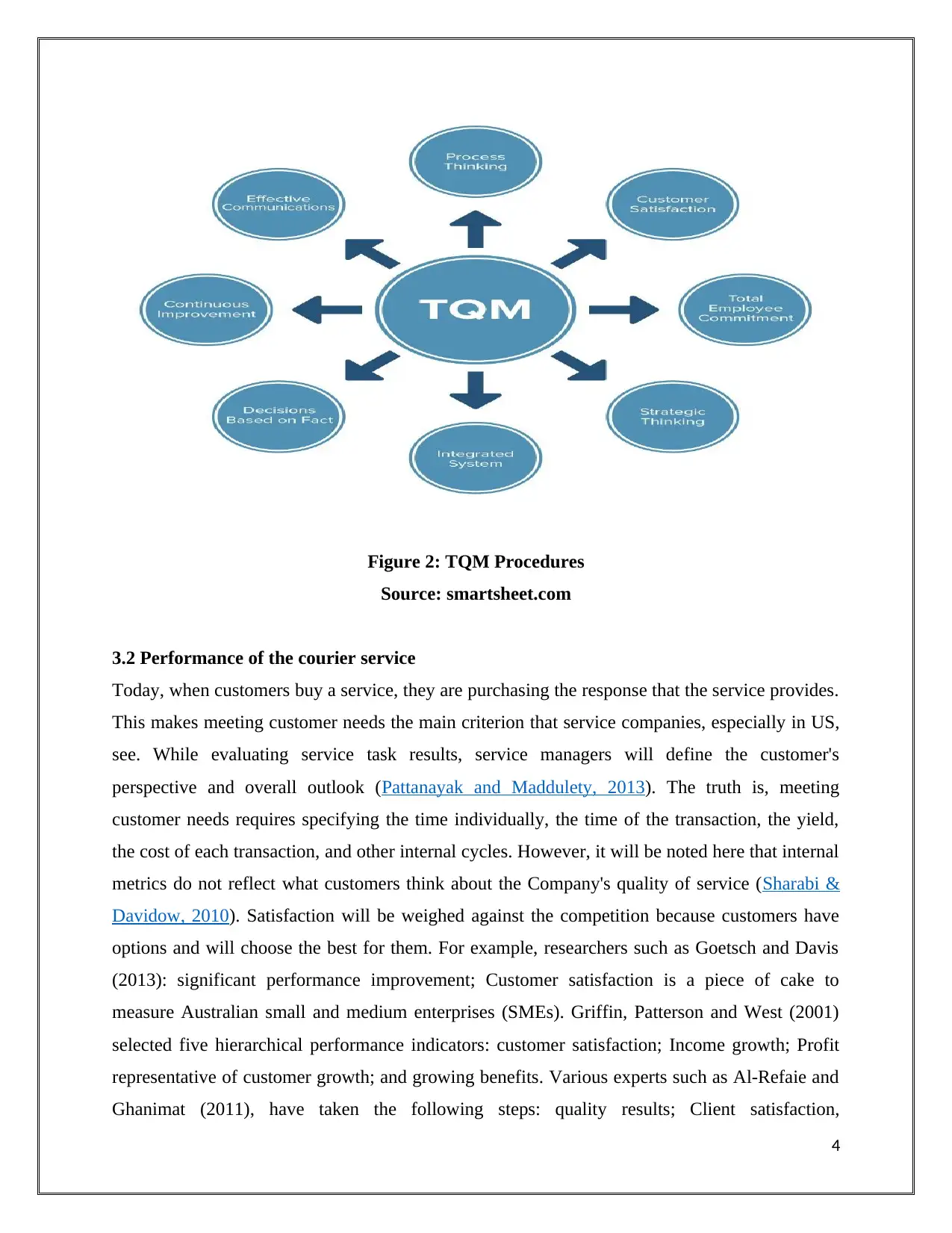
Figure 2: TQM Procedures
Source: smartsheet.com
3.2 Performance of the courier service
Today, when customers buy a service, they are purchasing the response that the service provides.
This makes meeting customer needs the main criterion that service companies, especially in US,
see. While evaluating service task results, service managers will define the customer's
perspective and overall outlook (Pattanayak and Maddulety, 2013). The truth is, meeting
customer needs requires specifying the time individually, the time of the transaction, the yield,
the cost of each transaction, and other internal cycles. However, it will be noted here that internal
metrics do not reflect what customers think about the Company's quality of service (Sharabi &
Davidow, 2010). Satisfaction will be weighed against the competition because customers have
options and will choose the best for them. For example, researchers such as Goetsch and Davis
(2013): significant performance improvement; Customer satisfaction is a piece of cake to
measure Australian small and medium enterprises (SMEs). Griffin, Patterson and West (2001)
selected five hierarchical performance indicators: customer satisfaction; Income growth; Profit
representative of customer growth; and growing benefits. Various experts such as Al-Refaie and
Ghanimat (2011), have taken the following steps: quality results; Client satisfaction,
4
Source: smartsheet.com
3.2 Performance of the courier service
Today, when customers buy a service, they are purchasing the response that the service provides.
This makes meeting customer needs the main criterion that service companies, especially in US,
see. While evaluating service task results, service managers will define the customer's
perspective and overall outlook (Pattanayak and Maddulety, 2013). The truth is, meeting
customer needs requires specifying the time individually, the time of the transaction, the yield,
the cost of each transaction, and other internal cycles. However, it will be noted here that internal
metrics do not reflect what customers think about the Company's quality of service (Sharabi &
Davidow, 2010). Satisfaction will be weighed against the competition because customers have
options and will choose the best for them. For example, researchers such as Goetsch and Davis
(2013): significant performance improvement; Customer satisfaction is a piece of cake to
measure Australian small and medium enterprises (SMEs). Griffin, Patterson and West (2001)
selected five hierarchical performance indicators: customer satisfaction; Income growth; Profit
representative of customer growth; and growing benefits. Various experts such as Al-Refaie and
Ghanimat (2011), have taken the following steps: quality results; Client satisfaction,
4
Paraphrase This Document
Need a fresh take? Get an instant paraphrase of this document with our AI Paraphraser
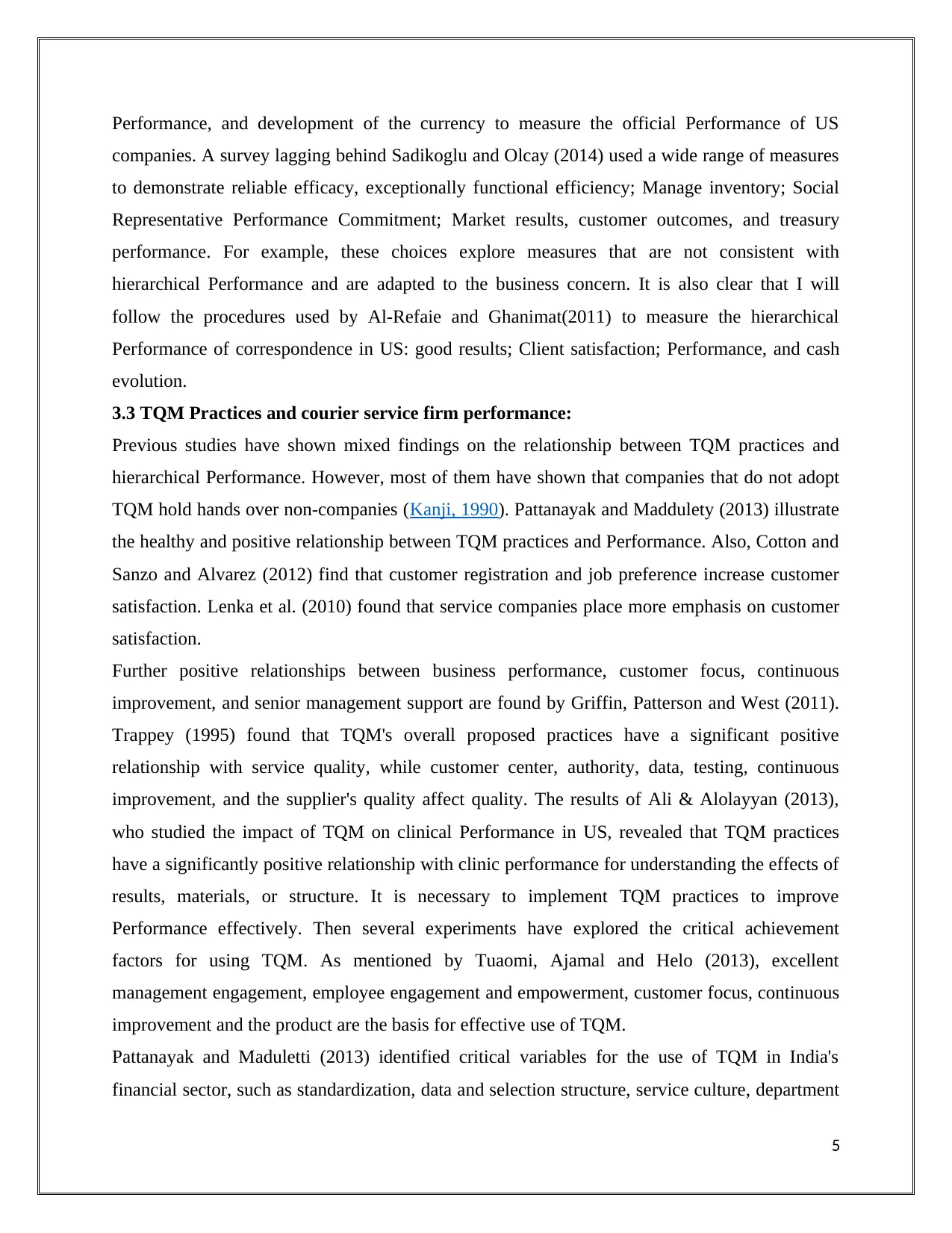
Performance, and development of the currency to measure the official Performance of US
companies. A survey lagging behind Sadikoglu and Olcay (2014) used a wide range of measures
to demonstrate reliable efficacy, exceptionally functional efficiency; Manage inventory; Social
Representative Performance Commitment; Market results, customer outcomes, and treasury
performance. For example, these choices explore measures that are not consistent with
hierarchical Performance and are adapted to the business concern. It is also clear that I will
follow the procedures used by Al-Refaie and Ghanimat(2011) to measure the hierarchical
Performance of correspondence in US: good results; Client satisfaction; Performance, and cash
evolution.
3.3 TQM Practices and courier service firm performance:
Previous studies have shown mixed findings on the relationship between TQM practices and
hierarchical Performance. However, most of them have shown that companies that do not adopt
TQM hold hands over non-companies (Kanji, 1990). Pattanayak and Maddulety (2013) illustrate
the healthy and positive relationship between TQM practices and Performance. Also, Cotton and
Sanzo and Alvarez (2012) find that customer registration and job preference increase customer
satisfaction. Lenka et al. (2010) found that service companies place more emphasis on customer
satisfaction.
Further positive relationships between business performance, customer focus, continuous
improvement, and senior management support are found by Griffin, Patterson and West (2011).
Trappey (1995) found that TQM's overall proposed practices have a significant positive
relationship with service quality, while customer center, authority, data, testing, continuous
improvement, and the supplier's quality affect quality. The results of Ali & Alolayyan (2013),
who studied the impact of TQM on clinical Performance in US, revealed that TQM practices
have a significantly positive relationship with clinic performance for understanding the effects of
results, materials, or structure. It is necessary to implement TQM practices to improve
Performance effectively. Then several experiments have explored the critical achievement
factors for using TQM. As mentioned by Tuaomi, Ajamal and Helo (2013), excellent
management engagement, employee engagement and empowerment, customer focus, continuous
improvement and the product are the basis for effective use of TQM.
Pattanayak and Maduletti (2013) identified critical variables for the use of TQM in India's
financial sector, such as standardization, data and selection structure, service culture, department
5
companies. A survey lagging behind Sadikoglu and Olcay (2014) used a wide range of measures
to demonstrate reliable efficacy, exceptionally functional efficiency; Manage inventory; Social
Representative Performance Commitment; Market results, customer outcomes, and treasury
performance. For example, these choices explore measures that are not consistent with
hierarchical Performance and are adapted to the business concern. It is also clear that I will
follow the procedures used by Al-Refaie and Ghanimat(2011) to measure the hierarchical
Performance of correspondence in US: good results; Client satisfaction; Performance, and cash
evolution.
3.3 TQM Practices and courier service firm performance:
Previous studies have shown mixed findings on the relationship between TQM practices and
hierarchical Performance. However, most of them have shown that companies that do not adopt
TQM hold hands over non-companies (Kanji, 1990). Pattanayak and Maddulety (2013) illustrate
the healthy and positive relationship between TQM practices and Performance. Also, Cotton and
Sanzo and Alvarez (2012) find that customer registration and job preference increase customer
satisfaction. Lenka et al. (2010) found that service companies place more emphasis on customer
satisfaction.
Further positive relationships between business performance, customer focus, continuous
improvement, and senior management support are found by Griffin, Patterson and West (2011).
Trappey (1995) found that TQM's overall proposed practices have a significant positive
relationship with service quality, while customer center, authority, data, testing, continuous
improvement, and the supplier's quality affect quality. The results of Ali & Alolayyan (2013),
who studied the impact of TQM on clinical Performance in US, revealed that TQM practices
have a significantly positive relationship with clinic performance for understanding the effects of
results, materials, or structure. It is necessary to implement TQM practices to improve
Performance effectively. Then several experiments have explored the critical achievement
factors for using TQM. As mentioned by Tuaomi, Ajamal and Helo (2013), excellent
management engagement, employee engagement and empowerment, customer focus, continuous
improvement and the product are the basis for effective use of TQM.
Pattanayak and Maduletti (2013) identified critical variables for the use of TQM in India's
financial sector, such as standardization, data and selection structure, service culture, department
5
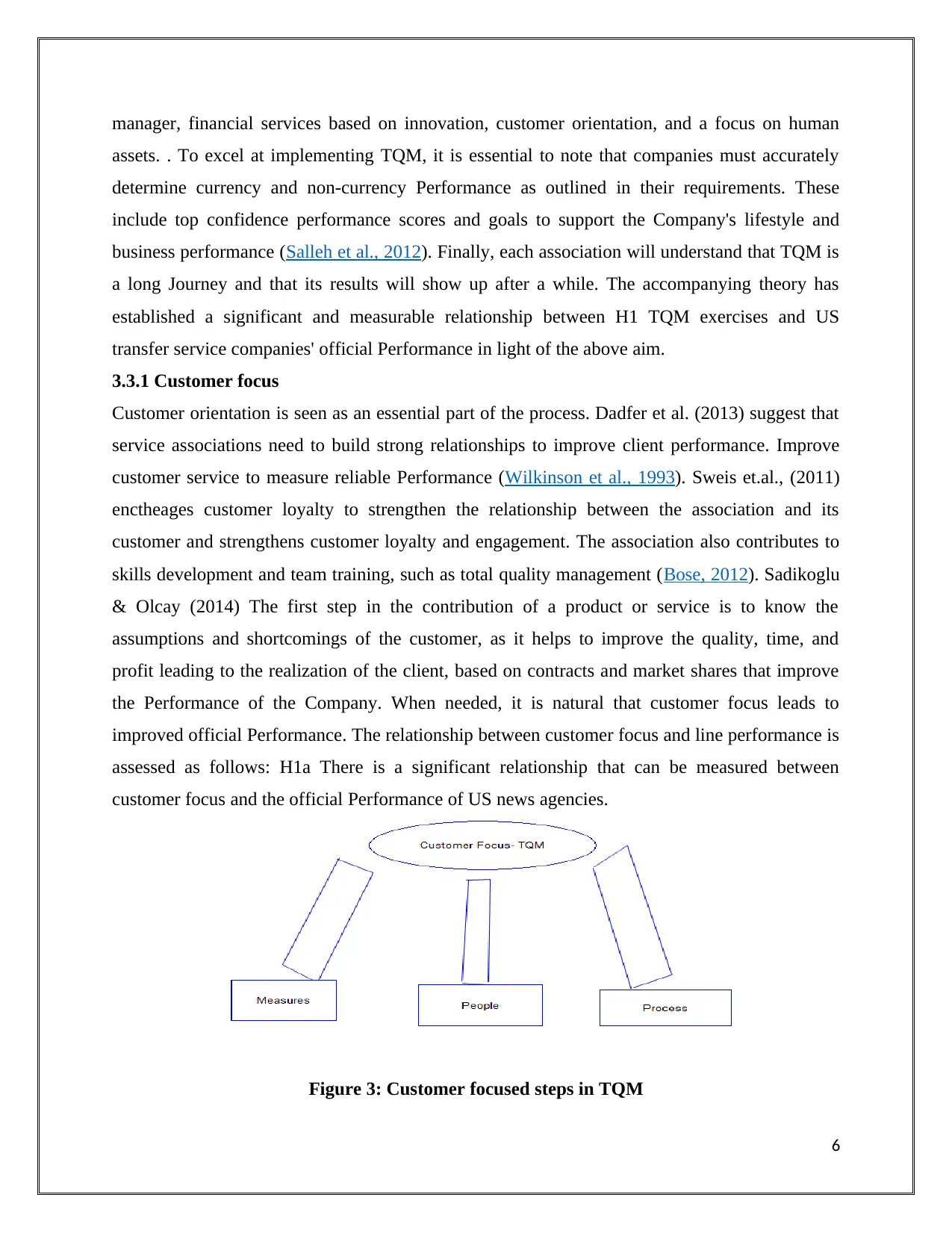
manager, financial services based on innovation, customer orientation, and a focus on human
assets. . To excel at implementing TQM, it is essential to note that companies must accurately
determine currency and non-currency Performance as outlined in their requirements. These
include top confidence performance scores and goals to support the Company's lifestyle and
business performance (Salleh et al., 2012). Finally, each association will understand that TQM is
a long Journey and that its results will show up after a while. The accompanying theory has
established a significant and measurable relationship between H1 TQM exercises and US
transfer service companies' official Performance in light of the above aim.
3.3.1 Customer focus
Customer orientation is seen as an essential part of the process. Dadfer et al. (2013) suggest that
service associations need to build strong relationships to improve client performance. Improve
customer service to measure reliable Performance (Wilkinson et al., 1993). Sweis et.al., (2011)
enctheages customer loyalty to strengthen the relationship between the association and its
customer and strengthens customer loyalty and engagement. The association also contributes to
skills development and team training, such as total quality management (Bose, 2012). Sadikoglu
& Olcay (2014) The first step in the contribution of a product or service is to know the
assumptions and shortcomings of the customer, as it helps to improve the quality, time, and
profit leading to the realization of the client, based on contracts and market shares that improve
the Performance of the Company. When needed, it is natural that customer focus leads to
improved official Performance. The relationship between customer focus and line performance is
assessed as follows: H1a There is a significant relationship that can be measured between
customer focus and the official Performance of US news agencies.
Figure 3: Customer focused steps in TQM
6
assets. . To excel at implementing TQM, it is essential to note that companies must accurately
determine currency and non-currency Performance as outlined in their requirements. These
include top confidence performance scores and goals to support the Company's lifestyle and
business performance (Salleh et al., 2012). Finally, each association will understand that TQM is
a long Journey and that its results will show up after a while. The accompanying theory has
established a significant and measurable relationship between H1 TQM exercises and US
transfer service companies' official Performance in light of the above aim.
3.3.1 Customer focus
Customer orientation is seen as an essential part of the process. Dadfer et al. (2013) suggest that
service associations need to build strong relationships to improve client performance. Improve
customer service to measure reliable Performance (Wilkinson et al., 1993). Sweis et.al., (2011)
enctheages customer loyalty to strengthen the relationship between the association and its
customer and strengthens customer loyalty and engagement. The association also contributes to
skills development and team training, such as total quality management (Bose, 2012). Sadikoglu
& Olcay (2014) The first step in the contribution of a product or service is to know the
assumptions and shortcomings of the customer, as it helps to improve the quality, time, and
profit leading to the realization of the client, based on contracts and market shares that improve
the Performance of the Company. When needed, it is natural that customer focus leads to
improved official Performance. The relationship between customer focus and line performance is
assessed as follows: H1a There is a significant relationship that can be measured between
customer focus and the official Performance of US news agencies.
Figure 3: Customer focused steps in TQM
6
⊘ This is a preview!⊘
Do you want full access?
Subscribe today to unlock all pages.

Trusted by 1+ million students worldwide
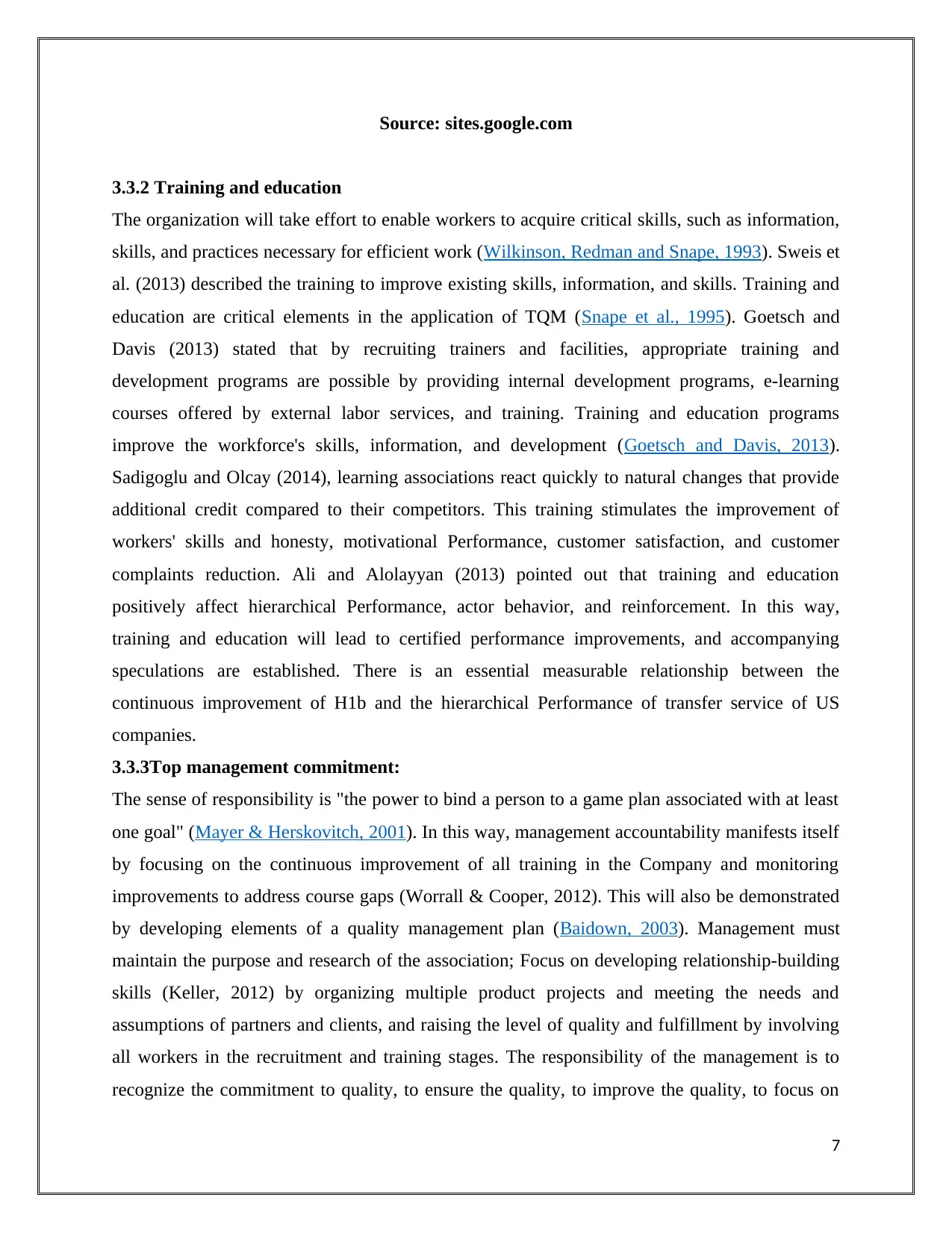
Source: sites.google.com
3.3.2 Training and education
The organization will take effort to enable workers to acquire critical skills, such as information,
skills, and practices necessary for efficient work (Wilkinson, Redman and Snape, 1993). Sweis et
al. (2013) described the training to improve existing skills, information, and skills. Training and
education are critical elements in the application of TQM (Snape et al., 1995). Goetsch and
Davis (2013) stated that by recruiting trainers and facilities, appropriate training and
development programs are possible by providing internal development programs, e-learning
courses offered by external labor services, and training. Training and education programs
improve the workforce's skills, information, and development (Goetsch and Davis, 2013).
Sadigoglu and Olcay (2014), learning associations react quickly to natural changes that provide
additional credit compared to their competitors. This training stimulates the improvement of
workers' skills and honesty, motivational Performance, customer satisfaction, and customer
complaints reduction. Ali and Alolayyan (2013) pointed out that training and education
positively affect hierarchical Performance, actor behavior, and reinforcement. In this way,
training and education will lead to certified performance improvements, and accompanying
speculations are established. There is an essential measurable relationship between the
continuous improvement of H1b and the hierarchical Performance of transfer service of US
companies.
3.3.3Top management commitment:
The sense of responsibility is "the power to bind a person to a game plan associated with at least
one goal" (Mayer & Herskovitch, 2001). In this way, management accountability manifests itself
by focusing on the continuous improvement of all training in the Company and monitoring
improvements to address course gaps (Worrall & Cooper, 2012). This will also be demonstrated
by developing elements of a quality management plan (Baidown, 2003). Management must
maintain the purpose and research of the association; Focus on developing relationship-building
skills (Keller, 2012) by organizing multiple product projects and meeting the needs and
assumptions of partners and clients, and raising the level of quality and fulfillment by involving
all workers in the recruitment and training stages. The responsibility of the management is to
recognize the commitment to quality, to ensure the quality, to improve the quality, to focus on
7
3.3.2 Training and education
The organization will take effort to enable workers to acquire critical skills, such as information,
skills, and practices necessary for efficient work (Wilkinson, Redman and Snape, 1993). Sweis et
al. (2013) described the training to improve existing skills, information, and skills. Training and
education are critical elements in the application of TQM (Snape et al., 1995). Goetsch and
Davis (2013) stated that by recruiting trainers and facilities, appropriate training and
development programs are possible by providing internal development programs, e-learning
courses offered by external labor services, and training. Training and education programs
improve the workforce's skills, information, and development (Goetsch and Davis, 2013).
Sadigoglu and Olcay (2014), learning associations react quickly to natural changes that provide
additional credit compared to their competitors. This training stimulates the improvement of
workers' skills and honesty, motivational Performance, customer satisfaction, and customer
complaints reduction. Ali and Alolayyan (2013) pointed out that training and education
positively affect hierarchical Performance, actor behavior, and reinforcement. In this way,
training and education will lead to certified performance improvements, and accompanying
speculations are established. There is an essential measurable relationship between the
continuous improvement of H1b and the hierarchical Performance of transfer service of US
companies.
3.3.3Top management commitment:
The sense of responsibility is "the power to bind a person to a game plan associated with at least
one goal" (Mayer & Herskovitch, 2001). In this way, management accountability manifests itself
by focusing on the continuous improvement of all training in the Company and monitoring
improvements to address course gaps (Worrall & Cooper, 2012). This will also be demonstrated
by developing elements of a quality management plan (Baidown, 2003). Management must
maintain the purpose and research of the association; Focus on developing relationship-building
skills (Keller, 2012) by organizing multiple product projects and meeting the needs and
assumptions of partners and clients, and raising the level of quality and fulfillment by involving
all workers in the recruitment and training stages. The responsibility of the management is to
recognize the commitment to quality, to ensure the quality, to improve the quality, to focus on
7
Paraphrase This Document
Need a fresh take? Get an instant paraphrase of this document with our AI Paraphraser
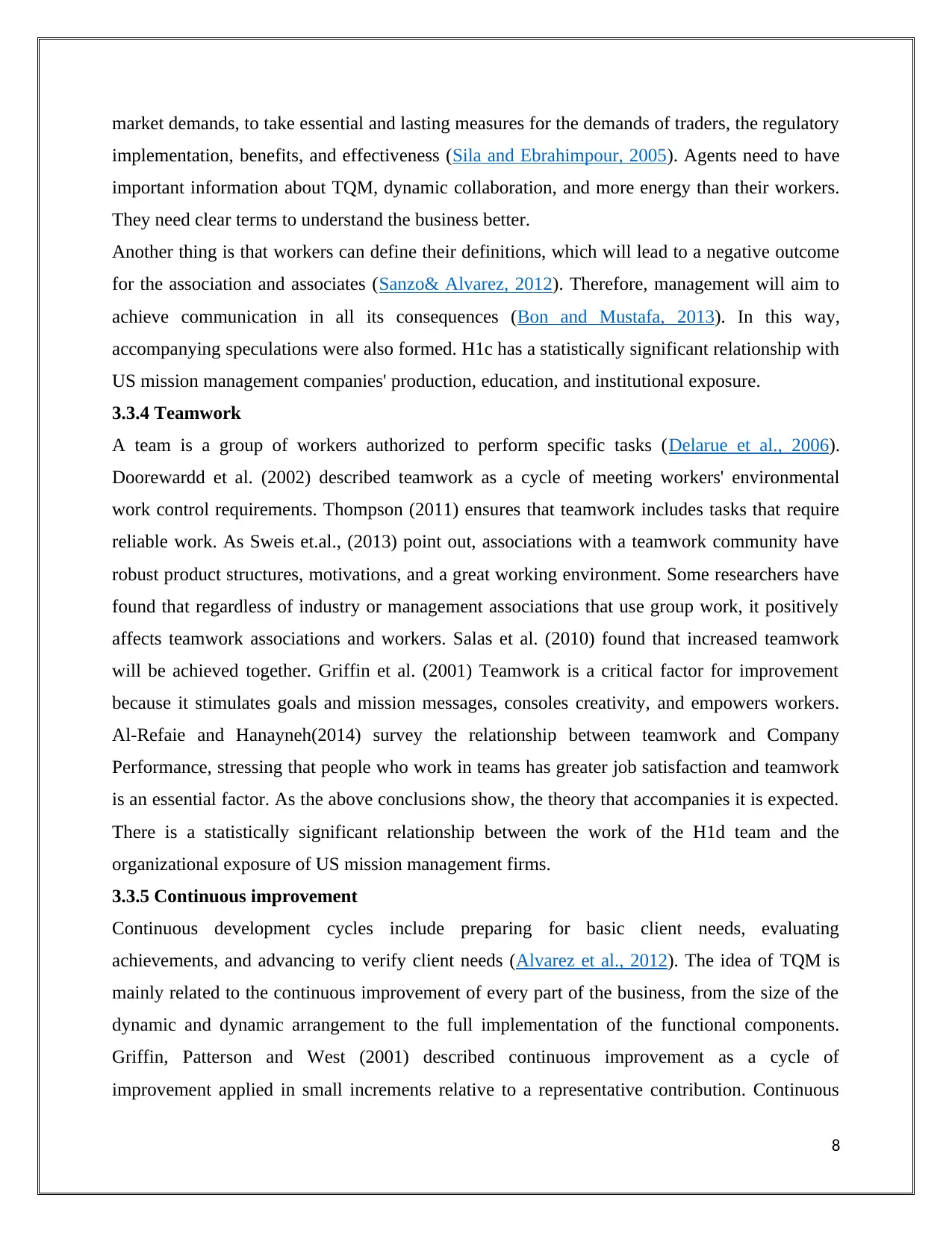
market demands, to take essential and lasting measures for the demands of traders, the regulatory
implementation, benefits, and effectiveness (Sila and Ebrahimpour, 2005). Agents need to have
important information about TQM, dynamic collaboration, and more energy than their workers.
They need clear terms to understand the business better.
Another thing is that workers can define their definitions, which will lead to a negative outcome
for the association and associates (Sanzo& Alvarez, 2012). Therefore, management will aim to
achieve communication in all its consequences (Bon and Mustafa, 2013). In this way,
accompanying speculations were also formed. H1c has a statistically significant relationship with
US mission management companies' production, education, and institutional exposure.
3.3.4 Teamwork
A team is a group of workers authorized to perform specific tasks (Delarue et al., 2006).
Doorewardd et al. (2002) described teamwork as a cycle of meeting workers' environmental
work control requirements. Thompson (2011) ensures that teamwork includes tasks that require
reliable work. As Sweis et.al., (2013) point out, associations with a teamwork community have
robust product structures, motivations, and a great working environment. Some researchers have
found that regardless of industry or management associations that use group work, it positively
affects teamwork associations and workers. Salas et al. (2010) found that increased teamwork
will be achieved together. Griffin et al. (2001) Teamwork is a critical factor for improvement
because it stimulates goals and mission messages, consoles creativity, and empowers workers.
Al-Refaie and Hanayneh(2014) survey the relationship between teamwork and Company
Performance, stressing that people who work in teams has greater job satisfaction and teamwork
is an essential factor. As the above conclusions show, the theory that accompanies it is expected.
There is a statistically significant relationship between the work of the H1d team and the
organizational exposure of US mission management firms.
3.3.5 Continuous improvement
Continuous development cycles include preparing for basic client needs, evaluating
achievements, and advancing to verify client needs (Alvarez et al., 2012). The idea of TQM is
mainly related to the continuous improvement of every part of the business, from the size of the
dynamic and dynamic arrangement to the full implementation of the functional components.
Griffin, Patterson and West (2001) described continuous improvement as a cycle of
improvement applied in small increments relative to a representative contribution. Continuous
8
implementation, benefits, and effectiveness (Sila and Ebrahimpour, 2005). Agents need to have
important information about TQM, dynamic collaboration, and more energy than their workers.
They need clear terms to understand the business better.
Another thing is that workers can define their definitions, which will lead to a negative outcome
for the association and associates (Sanzo& Alvarez, 2012). Therefore, management will aim to
achieve communication in all its consequences (Bon and Mustafa, 2013). In this way,
accompanying speculations were also formed. H1c has a statistically significant relationship with
US mission management companies' production, education, and institutional exposure.
3.3.4 Teamwork
A team is a group of workers authorized to perform specific tasks (Delarue et al., 2006).
Doorewardd et al. (2002) described teamwork as a cycle of meeting workers' environmental
work control requirements. Thompson (2011) ensures that teamwork includes tasks that require
reliable work. As Sweis et.al., (2013) point out, associations with a teamwork community have
robust product structures, motivations, and a great working environment. Some researchers have
found that regardless of industry or management associations that use group work, it positively
affects teamwork associations and workers. Salas et al. (2010) found that increased teamwork
will be achieved together. Griffin et al. (2001) Teamwork is a critical factor for improvement
because it stimulates goals and mission messages, consoles creativity, and empowers workers.
Al-Refaie and Hanayneh(2014) survey the relationship between teamwork and Company
Performance, stressing that people who work in teams has greater job satisfaction and teamwork
is an essential factor. As the above conclusions show, the theory that accompanies it is expected.
There is a statistically significant relationship between the work of the H1d team and the
organizational exposure of US mission management firms.
3.3.5 Continuous improvement
Continuous development cycles include preparing for basic client needs, evaluating
achievements, and advancing to verify client needs (Alvarez et al., 2012). The idea of TQM is
mainly related to the continuous improvement of every part of the business, from the size of the
dynamic and dynamic arrangement to the full implementation of the functional components.
Griffin, Patterson and West (2001) described continuous improvement as a cycle of
improvement applied in small increments relative to a representative contribution. Continuous
8
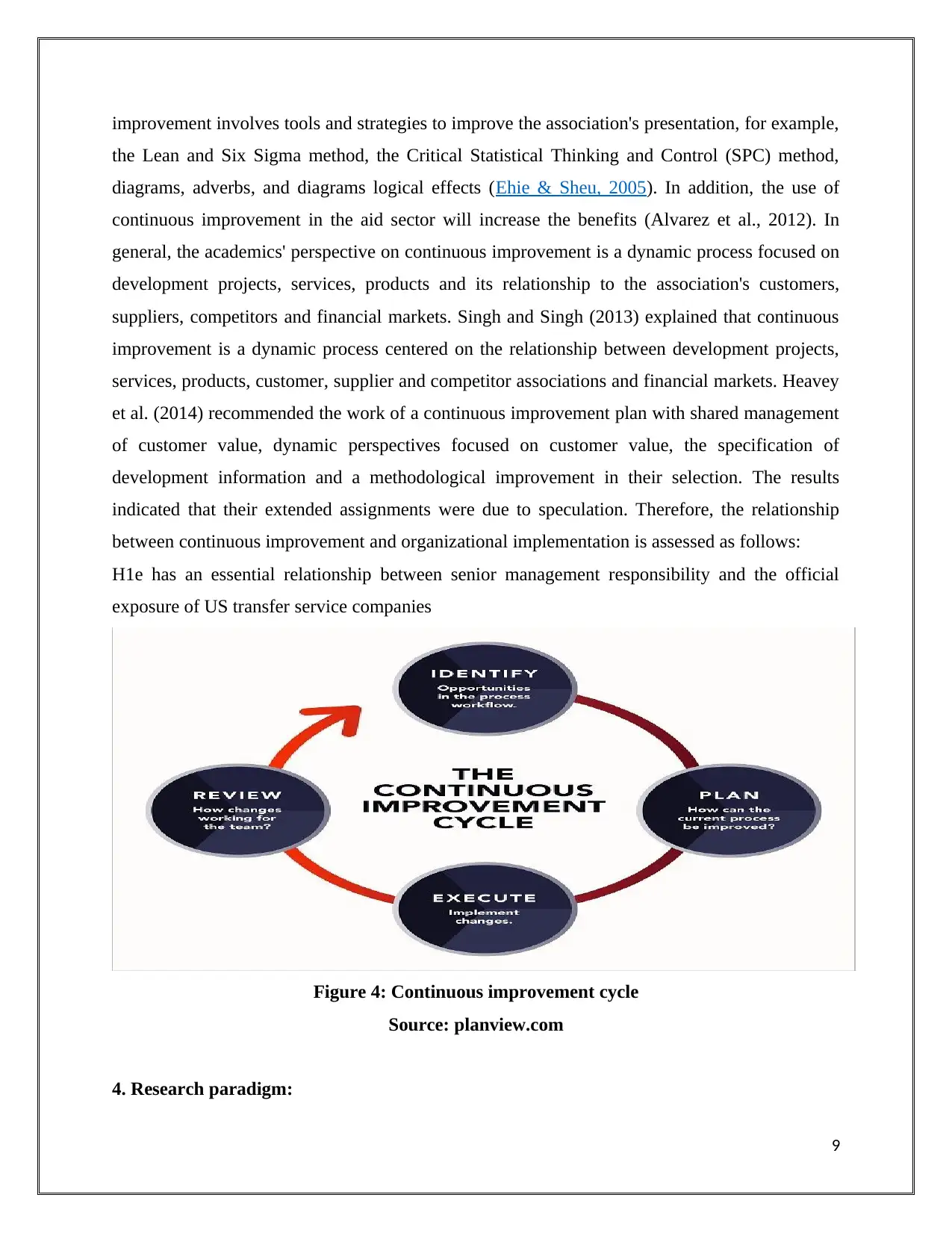
improvement involves tools and strategies to improve the association's presentation, for example,
the Lean and Six Sigma method, the Critical Statistical Thinking and Control (SPC) method,
diagrams, adverbs, and diagrams logical effects (Ehie & Sheu, 2005). In addition, the use of
continuous improvement in the aid sector will increase the benefits (Alvarez et al., 2012). In
general, the academics' perspective on continuous improvement is a dynamic process focused on
development projects, services, products and its relationship to the association's customers,
suppliers, competitors and financial markets. Singh and Singh (2013) explained that continuous
improvement is a dynamic process centered on the relationship between development projects,
services, products, customer, supplier and competitor associations and financial markets. Heavey
et al. (2014) recommended the work of a continuous improvement plan with shared management
of customer value, dynamic perspectives focused on customer value, the specification of
development information and a methodological improvement in their selection. The results
indicated that their extended assignments were due to speculation. Therefore, the relationship
between continuous improvement and organizational implementation is assessed as follows:
H1e has an essential relationship between senior management responsibility and the official
exposure of US transfer service companies
Figure 4: Continuous improvement cycle
Source: planview.com
4. Research paradigm:
9
the Lean and Six Sigma method, the Critical Statistical Thinking and Control (SPC) method,
diagrams, adverbs, and diagrams logical effects (Ehie & Sheu, 2005). In addition, the use of
continuous improvement in the aid sector will increase the benefits (Alvarez et al., 2012). In
general, the academics' perspective on continuous improvement is a dynamic process focused on
development projects, services, products and its relationship to the association's customers,
suppliers, competitors and financial markets. Singh and Singh (2013) explained that continuous
improvement is a dynamic process centered on the relationship between development projects,
services, products, customer, supplier and competitor associations and financial markets. Heavey
et al. (2014) recommended the work of a continuous improvement plan with shared management
of customer value, dynamic perspectives focused on customer value, the specification of
development information and a methodological improvement in their selection. The results
indicated that their extended assignments were due to speculation. Therefore, the relationship
between continuous improvement and organizational implementation is assessed as follows:
H1e has an essential relationship between senior management responsibility and the official
exposure of US transfer service companies
Figure 4: Continuous improvement cycle
Source: planview.com
4. Research paradigm:
9
⊘ This is a preview!⊘
Do you want full access?
Subscribe today to unlock all pages.

Trusted by 1+ million students worldwide
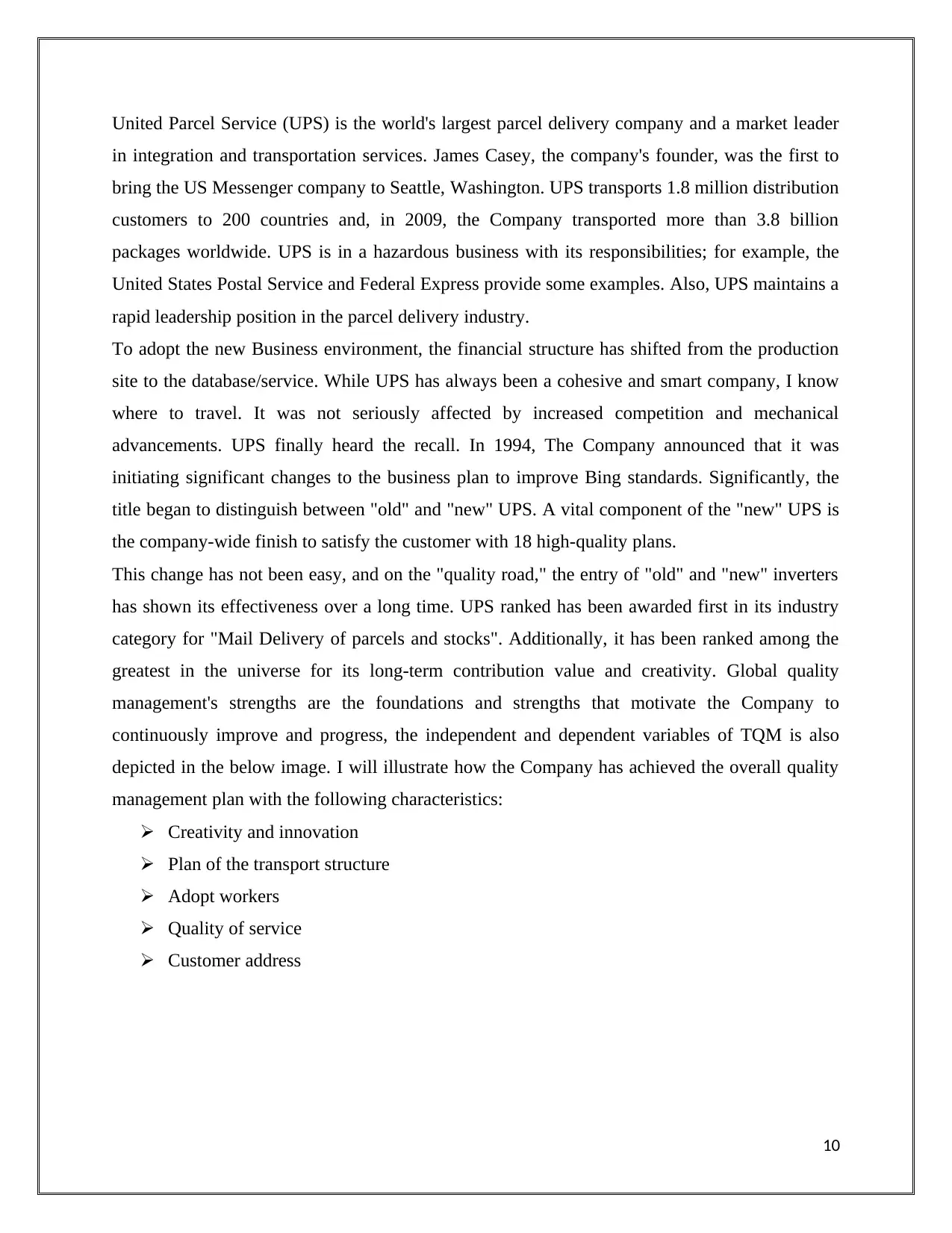
United Parcel Service (UPS) is the world's largest parcel delivery company and a market leader
in integration and transportation services. James Casey, the company's founder, was the first to
bring the US Messenger company to Seattle, Washington. UPS transports 1.8 million distribution
customers to 200 countries and, in 2009, the Company transported more than 3.8 billion
packages worldwide. UPS is in a hazardous business with its responsibilities; for example, the
United States Postal Service and Federal Express provide some examples. Also, UPS maintains a
rapid leadership position in the parcel delivery industry.
To adopt the new Business environment, the financial structure has shifted from the production
site to the database/service. While UPS has always been a cohesive and smart company, I know
where to travel. It was not seriously affected by increased competition and mechanical
advancements. UPS finally heard the recall. In 1994, The Company announced that it was
initiating significant changes to the business plan to improve Bing standards. Significantly, the
title began to distinguish between "old" and "new" UPS. A vital component of the "new" UPS is
the company-wide finish to satisfy the customer with 18 high-quality plans.
This change has not been easy, and on the "quality road," the entry of "old" and "new" inverters
has shown its effectiveness over a long time. UPS ranked has been awarded first in its industry
category for "Mail Delivery of parcels and stocks". Additionally, it has been ranked among the
greatest in the universe for its long-term contribution value and creativity. Global quality
management's strengths are the foundations and strengths that motivate the Company to
continuously improve and progress, the independent and dependent variables of TQM is also
depicted in the below image. I will illustrate how the Company has achieved the overall quality
management plan with the following characteristics:
Creativity and innovation
Plan of the transport structure
Adopt workers
Quality of service
Customer address
10
in integration and transportation services. James Casey, the company's founder, was the first to
bring the US Messenger company to Seattle, Washington. UPS transports 1.8 million distribution
customers to 200 countries and, in 2009, the Company transported more than 3.8 billion
packages worldwide. UPS is in a hazardous business with its responsibilities; for example, the
United States Postal Service and Federal Express provide some examples. Also, UPS maintains a
rapid leadership position in the parcel delivery industry.
To adopt the new Business environment, the financial structure has shifted from the production
site to the database/service. While UPS has always been a cohesive and smart company, I know
where to travel. It was not seriously affected by increased competition and mechanical
advancements. UPS finally heard the recall. In 1994, The Company announced that it was
initiating significant changes to the business plan to improve Bing standards. Significantly, the
title began to distinguish between "old" and "new" UPS. A vital component of the "new" UPS is
the company-wide finish to satisfy the customer with 18 high-quality plans.
This change has not been easy, and on the "quality road," the entry of "old" and "new" inverters
has shown its effectiveness over a long time. UPS ranked has been awarded first in its industry
category for "Mail Delivery of parcels and stocks". Additionally, it has been ranked among the
greatest in the universe for its long-term contribution value and creativity. Global quality
management's strengths are the foundations and strengths that motivate the Company to
continuously improve and progress, the independent and dependent variables of TQM is also
depicted in the below image. I will illustrate how the Company has achieved the overall quality
management plan with the following characteristics:
Creativity and innovation
Plan of the transport structure
Adopt workers
Quality of service
Customer address
10
Paraphrase This Document
Need a fresh take? Get an instant paraphrase of this document with our AI Paraphraser
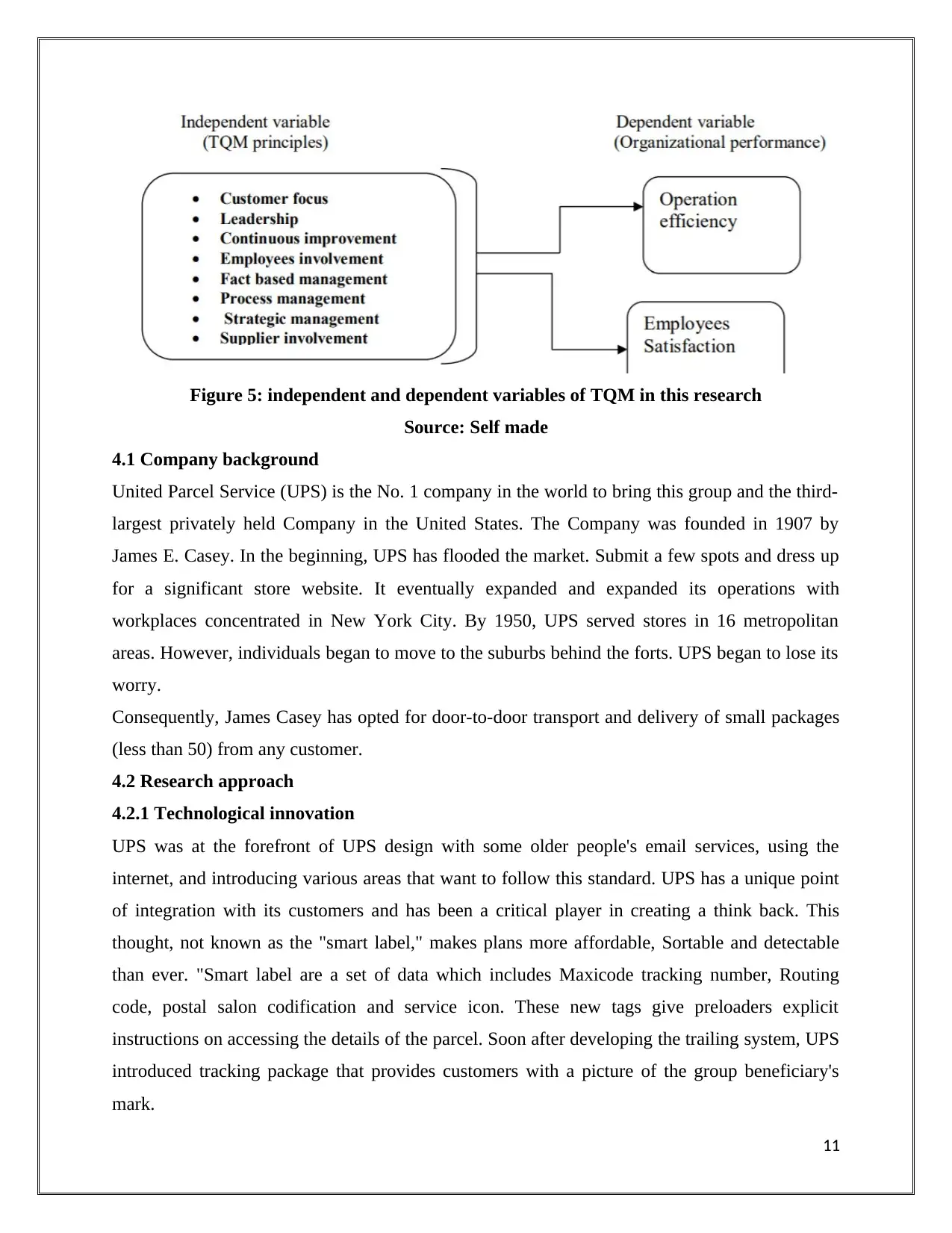
Figure 5: independent and dependent variables of TQM in this research
Source: Self made
4.1 Company background
United Parcel Service (UPS) is the No. 1 company in the world to bring this group and the third-
largest privately held Company in the United States. The Company was founded in 1907 by
James E. Casey. In the beginning, UPS has flooded the market. Submit a few spots and dress up
for a significant store website. It eventually expanded and expanded its operations with
workplaces concentrated in New York City. By 1950, UPS served stores in 16 metropolitan
areas. However, individuals began to move to the suburbs behind the forts. UPS began to lose its
worry.
Consequently, James Casey has opted for door-to-door transport and delivery of small packages
(less than 50) from any customer.
4.2 Research approach
4.2.1 Technological innovation
UPS was at the forefront of UPS design with some older people's email services, using the
internet, and introducing various areas that want to follow this standard. UPS has a unique point
of integration with its customers and has been a critical player in creating a think back. This
thought, not known as the "smart label," makes plans more affordable, Sortable and detectable
than ever. "Smart label are a set of data which includes Maxicode tracking number, Routing
code, postal salon codification and service icon. These new tags give preloaders explicit
instructions on accessing the details of the parcel. Soon after developing the trailing system, UPS
introduced tracking package that provides customers with a picture of the group beneficiary's
mark.
11
Source: Self made
4.1 Company background
United Parcel Service (UPS) is the No. 1 company in the world to bring this group and the third-
largest privately held Company in the United States. The Company was founded in 1907 by
James E. Casey. In the beginning, UPS has flooded the market. Submit a few spots and dress up
for a significant store website. It eventually expanded and expanded its operations with
workplaces concentrated in New York City. By 1950, UPS served stores in 16 metropolitan
areas. However, individuals began to move to the suburbs behind the forts. UPS began to lose its
worry.
Consequently, James Casey has opted for door-to-door transport and delivery of small packages
(less than 50) from any customer.
4.2 Research approach
4.2.1 Technological innovation
UPS was at the forefront of UPS design with some older people's email services, using the
internet, and introducing various areas that want to follow this standard. UPS has a unique point
of integration with its customers and has been a critical player in creating a think back. This
thought, not known as the "smart label," makes plans more affordable, Sortable and detectable
than ever. "Smart label are a set of data which includes Maxicode tracking number, Routing
code, postal salon codification and service icon. These new tags give preloaders explicit
instructions on accessing the details of the parcel. Soon after developing the trailing system, UPS
introduced tracking package that provides customers with a picture of the group beneficiary's
mark.
11
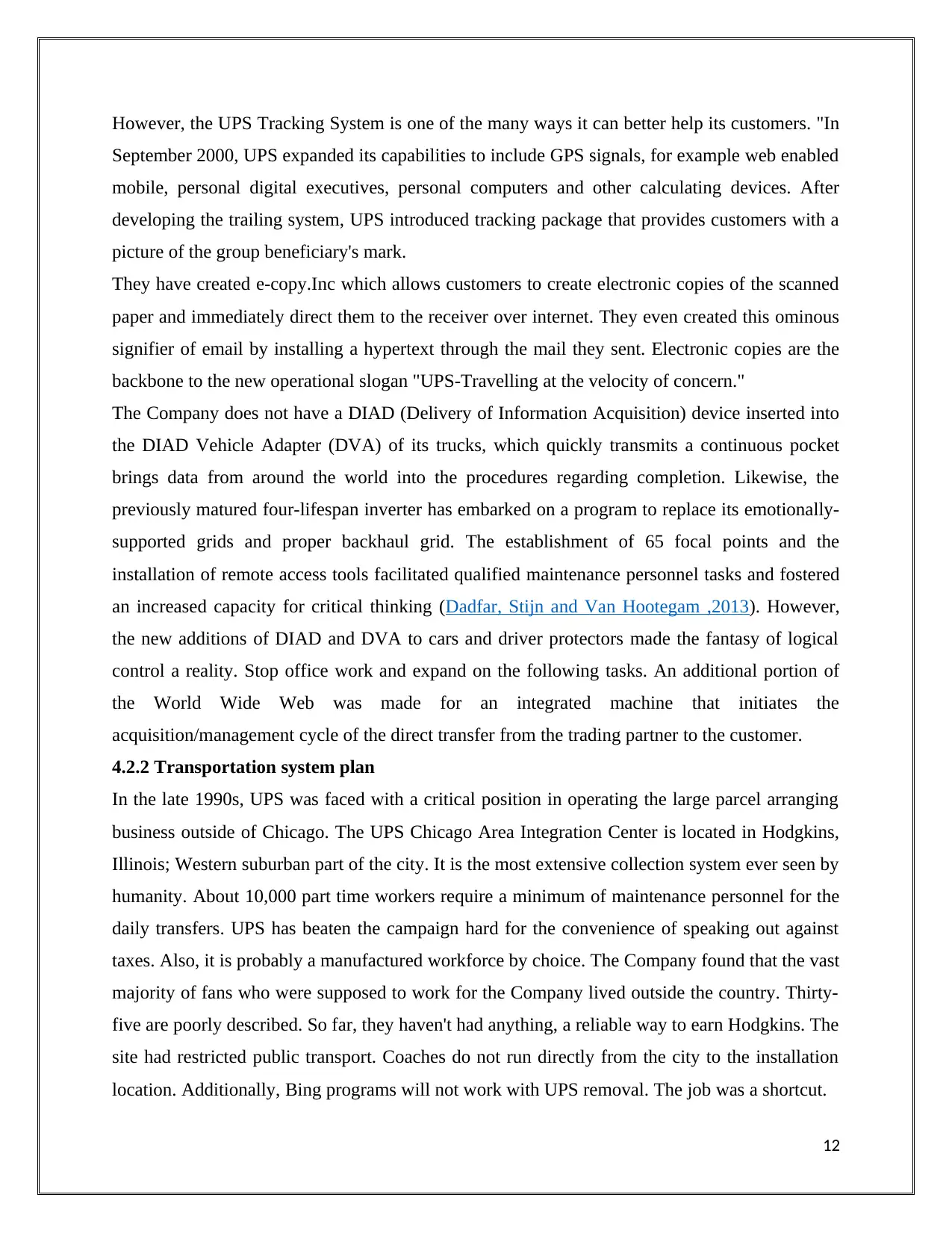
However, the UPS Tracking System is one of the many ways it can better help its customers. "In
September 2000, UPS expanded its capabilities to include GPS signals, for example web enabled
mobile, personal digital executives, personal computers and other calculating devices. After
developing the trailing system, UPS introduced tracking package that provides customers with a
picture of the group beneficiary's mark.
They have created e-copy.Inc which allows customers to create electronic copies of the scanned
paper and immediately direct them to the receiver over internet. They even created this ominous
signifier of email by installing a hypertext through the mail they sent. Electronic copies are the
backbone to the new operational slogan "UPS-Travelling at the velocity of concern."
The Company does not have a DIAD (Delivery of Information Acquisition) device inserted into
the DIAD Vehicle Adapter (DVA) of its trucks, which quickly transmits a continuous pocket
brings data from around the world into the procedures regarding completion. Likewise, the
previously matured four-lifespan inverter has embarked on a program to replace its emotionally-
supported grids and proper backhaul grid. The establishment of 65 focal points and the
installation of remote access tools facilitated qualified maintenance personnel tasks and fostered
an increased capacity for critical thinking (Dadfar, Stijn and Van Hootegam ,2013). However,
the new additions of DIAD and DVA to cars and driver protectors made the fantasy of logical
control a reality. Stop office work and expand on the following tasks. An additional portion of
the World Wide Web was made for an integrated machine that initiates the
acquisition/management cycle of the direct transfer from the trading partner to the customer.
4.2.2 Transportation system plan
In the late 1990s, UPS was faced with a critical position in operating the large parcel arranging
business outside of Chicago. The UPS Chicago Area Integration Center is located in Hodgkins,
Illinois; Western suburban part of the city. It is the most extensive collection system ever seen by
humanity. About 10,000 part time workers require a minimum of maintenance personnel for the
daily transfers. UPS has beaten the campaign hard for the convenience of speaking out against
taxes. Also, it is probably a manufactured workforce by choice. The Company found that the vast
majority of fans who were supposed to work for the Company lived outside the country. Thirty-
five are poorly described. So far, they haven't had anything, a reliable way to earn Hodgkins. The
site had restricted public transport. Coaches do not run directly from the city to the installation
location. Additionally, Bing programs will not work with UPS removal. The job was a shortcut.
12
September 2000, UPS expanded its capabilities to include GPS signals, for example web enabled
mobile, personal digital executives, personal computers and other calculating devices. After
developing the trailing system, UPS introduced tracking package that provides customers with a
picture of the group beneficiary's mark.
They have created e-copy.Inc which allows customers to create electronic copies of the scanned
paper and immediately direct them to the receiver over internet. They even created this ominous
signifier of email by installing a hypertext through the mail they sent. Electronic copies are the
backbone to the new operational slogan "UPS-Travelling at the velocity of concern."
The Company does not have a DIAD (Delivery of Information Acquisition) device inserted into
the DIAD Vehicle Adapter (DVA) of its trucks, which quickly transmits a continuous pocket
brings data from around the world into the procedures regarding completion. Likewise, the
previously matured four-lifespan inverter has embarked on a program to replace its emotionally-
supported grids and proper backhaul grid. The establishment of 65 focal points and the
installation of remote access tools facilitated qualified maintenance personnel tasks and fostered
an increased capacity for critical thinking (Dadfar, Stijn and Van Hootegam ,2013). However,
the new additions of DIAD and DVA to cars and driver protectors made the fantasy of logical
control a reality. Stop office work and expand on the following tasks. An additional portion of
the World Wide Web was made for an integrated machine that initiates the
acquisition/management cycle of the direct transfer from the trading partner to the customer.
4.2.2 Transportation system plan
In the late 1990s, UPS was faced with a critical position in operating the large parcel arranging
business outside of Chicago. The UPS Chicago Area Integration Center is located in Hodgkins,
Illinois; Western suburban part of the city. It is the most extensive collection system ever seen by
humanity. About 10,000 part time workers require a minimum of maintenance personnel for the
daily transfers. UPS has beaten the campaign hard for the convenience of speaking out against
taxes. Also, it is probably a manufactured workforce by choice. The Company found that the vast
majority of fans who were supposed to work for the Company lived outside the country. Thirty-
five are poorly described. So far, they haven't had anything, a reliable way to earn Hodgkins. The
site had restricted public transport. Coaches do not run directly from the city to the installation
location. Additionally, Bing programs will not work with UPS removal. The job was a shortcut.
12
⊘ This is a preview!⊘
Do you want full access?
Subscribe today to unlock all pages.

Trusted by 1+ million students worldwide
1 out of 26
Related Documents
Your All-in-One AI-Powered Toolkit for Academic Success.
+13062052269
info@desklib.com
Available 24*7 on WhatsApp / Email
![[object Object]](/_next/static/media/star-bottom.7253800d.svg)
Unlock your academic potential
Copyright © 2020–2025 A2Z Services. All Rights Reserved. Developed and managed by ZUCOL.




